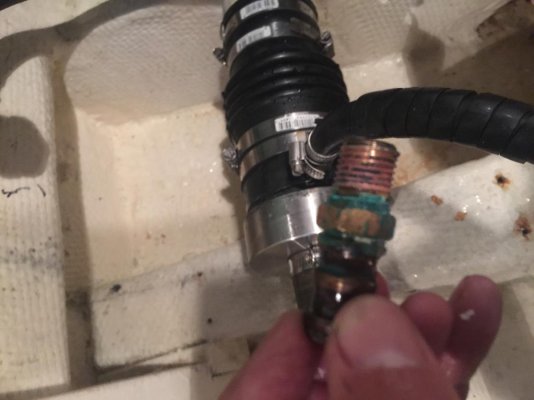mahal
Guru
- Joined
- May 26, 2010
- Messages
- 651
The hose barb on my PSS had been replaced by the P.O. with a brass one which is a no-no according to PYI.
Yesterday, when doing a post cruise inspection, I noticed water in the bilge caused by a steady stream from one of the PSS units. I saw that it was coming from the hose barb. The fitting was cracked at the base and broke off very easily as I was carefully removing the hose. Not good.
I did some internet research and learned that some folks with older PSS units replace their leaking nylon hose barbs with metal thinking that it's an upgrade. Which makes sense to me. But the person that I spoke to at PYI told me that this is a mistake. I pointed to him that the newer units come with stainless steel hose barbs and asked how that's different. He said that the metal hose barb on the newer units don't screw directly to the carbon material and has a lining/adapter in between. Only nylon hose barbs should be used for the older units.
If you have an older PSS, make sure the hose barb is nylon. It may just save you from the same stress I went through yesterday. It took a long time to remove the remaining brass piece out of the carbon stator and water was coming in during the process.
Can someone please explain why the brass fitting turned brittle. Was it the carbon material, salt water or something else. I did't want to ask too many questions from the PYI guy.
Yesterday, when doing a post cruise inspection, I noticed water in the bilge caused by a steady stream from one of the PSS units. I saw that it was coming from the hose barb. The fitting was cracked at the base and broke off very easily as I was carefully removing the hose. Not good.
I did some internet research and learned that some folks with older PSS units replace their leaking nylon hose barbs with metal thinking that it's an upgrade. Which makes sense to me. But the person that I spoke to at PYI told me that this is a mistake. I pointed to him that the newer units come with stainless steel hose barbs and asked how that's different. He said that the metal hose barb on the newer units don't screw directly to the carbon material and has a lining/adapter in between. Only nylon hose barbs should be used for the older units.
If you have an older PSS, make sure the hose barb is nylon. It may just save you from the same stress I went through yesterday. It took a long time to remove the remaining brass piece out of the carbon stator and water was coming in during the process.
Can someone please explain why the brass fitting turned brittle. Was it the carbon material, salt water or something else. I did't want to ask too many questions from the PYI guy.


